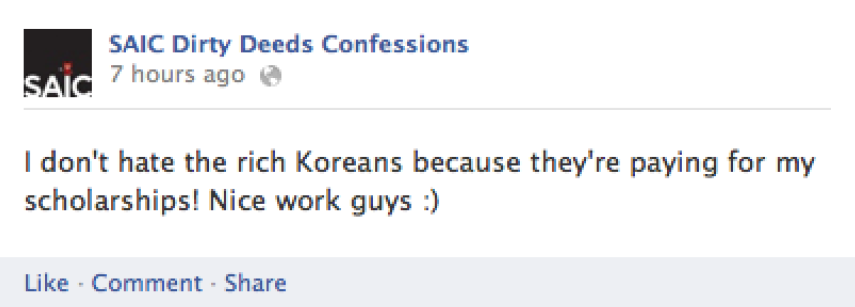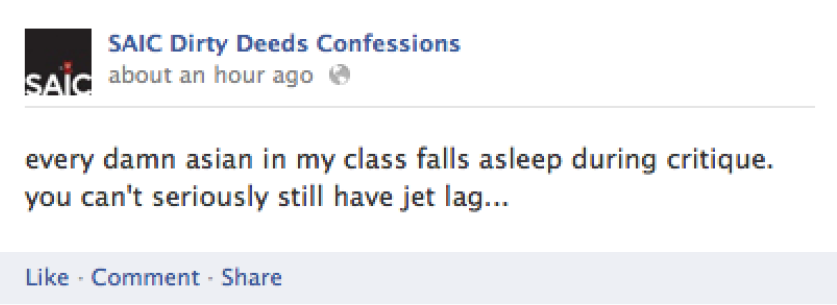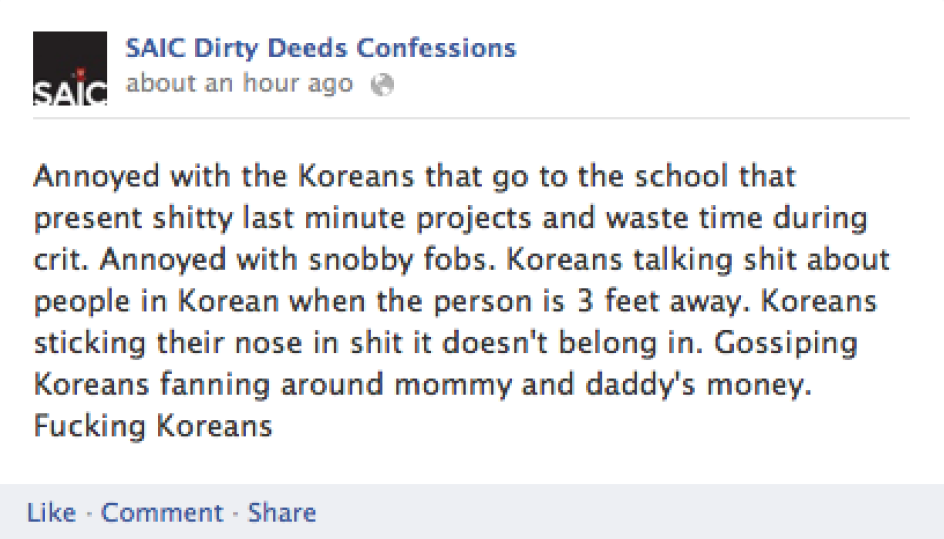
In 2013, I came across a Facebook page called “SAIC Dirty Deeds Confessions,” an unofficial page not affiliated with the School of the Art Institute of Chicago (SAIC). (The page has been taken down since this article’s publication.) Hiding behind anonymity, some of my schoolmates were not afraid to publicly bash students from Asia on the page, especially those from Korea.
Being a Korean student at SAIC, I decided to have a conversation with Campus Life officials about the hateful posts. I was told that the school was not responsible for the unaffiliated Facebook page. That was it. I’ve never met someone who has spoken out about this issue since then — neither within the international students’ community, nor in the broader school environment.
Two years after I saw those message boards, still wondering if the anti-Asian sentiments persisted, I decided to talk to other Asian international students about their experiences with stereotypes. The students I talked to said that they felt frustrated, annoyed, and angry to be associated with negative perceptions, but were reluctant to turn such feelings into a critical discussion about the school community.
“I’m aware that there is this ‘rich kid’ stereotype about Asian international students,” said one of the people I talked to (who did not wish to be identified), “but it is true to a certain extent, because there are students from Asia who act like the stereotype, so I don’t know if I can deny it.” When I asked him if he identified with the sentiment, he said no, and although the existence of such a belief bothers him, there is not much he can do about it.
Other interviewees acknowledged the prevalence of these attitudes at SAIC but were similarly reluctant to express their personal feelings about the issue.
Why do some of these students feel discouraged from rejecting these narratives? Why do they seem to prefer remaining silent? I imagine behind their silence is a complexity beyond the simple explanation: “Well, there are people like that.”
I asked Asian international students about experiences that led them to feel similarly disheartened.
According to SAIC’s website, “Most grants, scholarships, and loans from public and private sources in the United States are restricted to U.S. citizens or permanent residents, limiting the amount of information international students can find about financial aid from U.S. sources.” Because of those restrictions, international students at SAIC have limited access to scholarships, student loans, and jobs, which often causes them to depend more on their families’ funding. However, because of such inevitable reliance on family funding, international students are often viewed as “not having it hard enough.”
Sunyoung Hwang, a senior BFA student from Korea, said that a peer constantly asked about the costs of her materials. “In the last class of the semester, we did an activity that we wrote things we best liked about each other,” said Hwang. “I was paired with that classmate, and she wrote that I always spent a lot of money on materials for what she liked about me.”
Many students expressed discomfort regarding the school’s general treatment of Asian students, pointing to a lack of classes on diversity, teachers of color, and all-school level discussions on racial/cultural issues.
An international student from Korea who wished to remain anonymous said, “Although I must acknowledge that the separate Korean and Chinese student advisors can be a helpful resource for some who are not comfortable speaking to regular academic advisors due to a language barrier or cultural difference, I don’t like that the faculty members direct a student to the Korean or Chinese student advisors without a question if the said student is Korean or Chinese.”
The interviewee continued: “They treat us as if we have to go through our cultural representative to solve any problem on campus, even if we don’t have a language barrier, or the problem is unrelated to a cultural experience. It just feels like they don’t want to deal with Korean or Chinese students themselves and relegate their responsibility to these specific advisors.”
Another interviewee who wished to remain anonymous shared her experience of being labeled as a foreigner by school faculty. She was sexually harassed on the train, but when she discussed this with a school official, the official was unhelpful. She explained, “[My adviser] said I encountered that because I look like a tourist. She also recommended that I wear more humble outfits and not carry expensive cameras.”
After speaking with these students, I couldn’t help but ask: Are some of us simply quiet and complacent, or are we just tired of discussing these issues because others haven’t listened?
The Facebook page provided an anonymity that protected hateful speeech. And interestingly, anonymity was also important for some of the interviewees — and perhaps for good reason. But how might these realities intersect in a way that further diminishes the voices of Asian students on campus?
International students go through a lot to be admitted to SAIC. Merely attending the school is a tremendous amount of work — not only because of the burden of retaining immigration status paper trails, speaking a foreign language at college level, and keeping up with American culture in order to conduct small talk with peers. And what may seem to some like insignficant slights can actually contribute to an omnipresent feeling of marginalization.
These discriminatory remarks take up a significant portion of our lives. Some of us feel pressured to assimilate and have sometimes been made to feel less visible on campus.
So the question remains: Will we be silent?











lmfao. This article sounds really whiney.
Fantastic!
“And what may seem to some like insignificant slights can actually contribute to an omnipresent feeling of marginalization.”
THANK YOU THANK YOU THANK YOU!